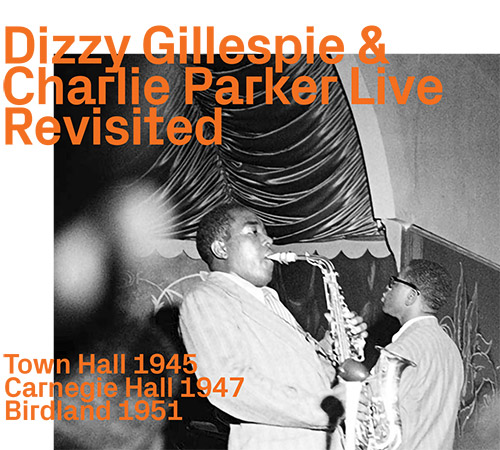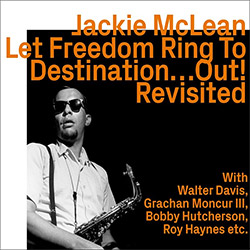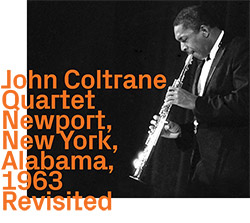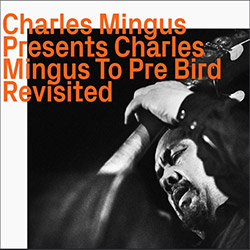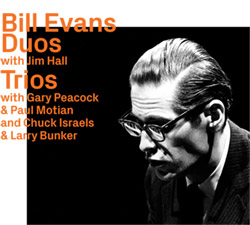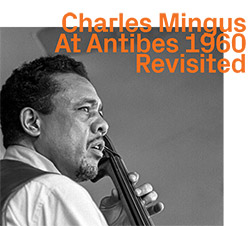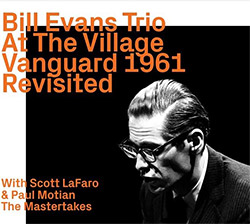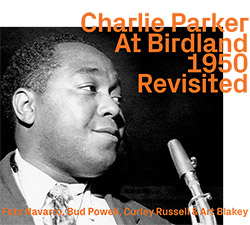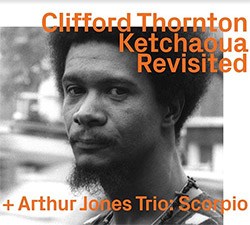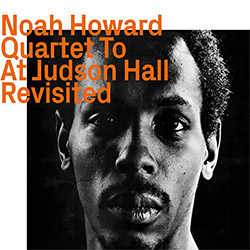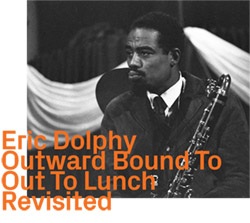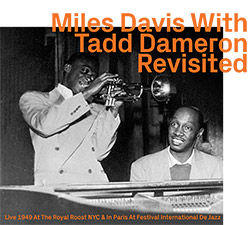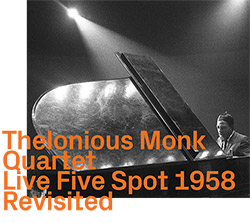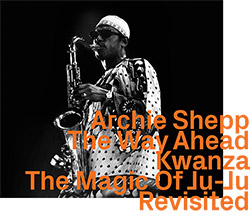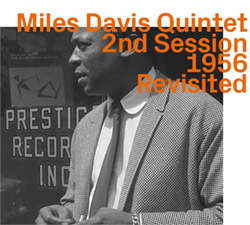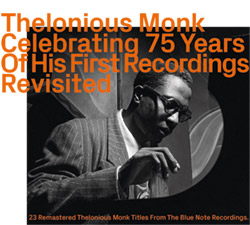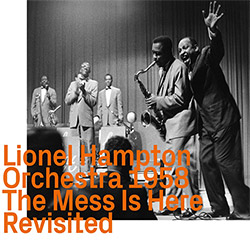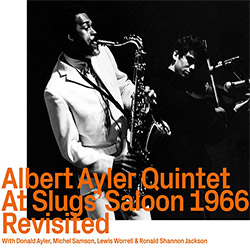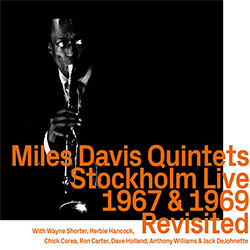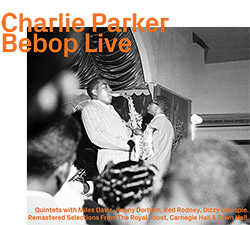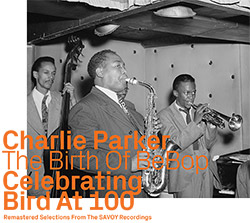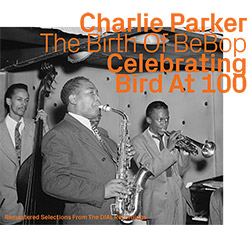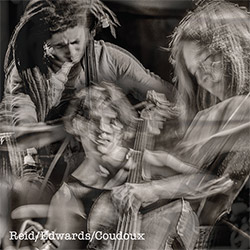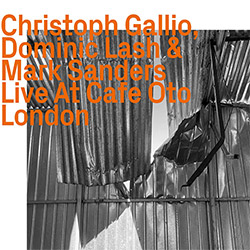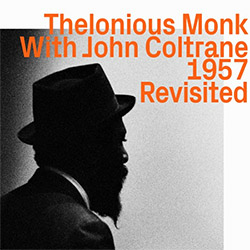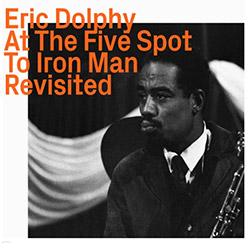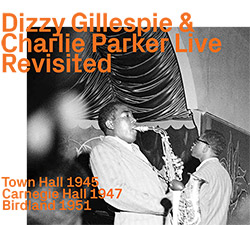
Three essential concerts remastered, from the legacy of be-bop trailblazers, trumpeter Dizzy Gillespie and alto saxophonist Charlie Parker, with Don Byas, Al Haig piano, Curley Russell, Max Roach & Sidney Catlett at Town Hall 1945; with John Lewis, Al McKibbon & Joe Harris at Carnegie Hall 1947; and with Bud Powell, Tommy Potter & Roy Haynes at Birdland 1951.
In Stock
Quantity in Basket: None
Log In to use our Wish List
Shipping Weight: 2.00 units
Sample The Album:
Dizzy Gillespie-trumpet
Charlie Parker-alto saxophone
Don Byas-tenor saxophone (track 1)
Al Haig-piano
John Lewis-piano
Bud Powell-piano
Al McKibbon-double bass
Joe Harris-drums
Curley Russell-double bass
Tommy Potter-double bass
Max Roach-drums (tracks 1,2,3,4)
Roy Haynes-drums
Sidney Catlett-drums (track 5, 6)
Click an artist name above to see in-stock items for that artist.
UPC: 752156115625
Label: ezz-thetics by Hat Hut Records Ltd
Catalog ID: ezz-thetics 1156
Squidco Product Code: 33341
Format: CD
Condition: New
Released: 2023
Country: Switzerland
Packaging: Cardboard Gatefold
Tracks 1-6 Recorded June 22, 1945 at Town Hall, New York City. Tracks 7-11 Recorded September 29, 1947 at Carnegie Hall, New York City. Tracks 12-15 Recorded March 31, 1951 at Birdland, New York City.
"When Charlie Parker and Dizzy Gillespie went into the recording studio together on 28 February 1945, they had already served a shared apprenticeship in the big bands of Earl Hines and Billy Eckstine, had jammed informally exploring their common interest in adventurous extensions of swing harmonies and reconfigured rhythms, and were, individually and collaboratively, prepared to redirect the course of modern jazz. That session shouldn't in any way be considered the public "birth" of bebop; those seeds had already been sown by Dizzy in recordings with, respectively, Don Byas and Dexter Gordon. But the pairing of Parker and Gillespie at this time was to prove noteworthy for two circumstances - their brilliance together, and (despite future recognition as the seemingly joined-at-the-hip father figures of bebop) the subsequent rarity of their appearances in partnership, facts that account for the importance of this collection of live performances.
By 1945, Gillespie had a more impressive reputation in musical circles and was better known among jazz fans than Parker. In addition to his startling trumpeting, he had produced arrangements for big bands ranging from Eckstine's to Woody Herman's, and was already responsible for composing what quickly became bebop's core repertoire. So Gillespie's personality was primed for bigger successes, thus his persistence in fronting a big band between 1946 and '50, after which time the market no longer supported them. Thereafter, his small combos featured saxophonists Byas, Sonny Stitt, Jimmy Heath, John Coltrane, and Hank Mobley among others - but not Bird, who, working under a different booking agent, primarily free-lanced as a guest soloist the last five years of his life. Those occasions when they reunited are now the stuff of legend.
The first of these special events is the June '45 Town Hall concert. This was intended to be an extravaganza showcasing several bands and assorted special guests - which explains the presence of Byas (the thrilling tenor sax soloist on the initial recording of "Bebop" and "Salt Peanuts" six months earlier, and who throughout his career never received the acclaim his exceptional playing deserved) and Sid Catlett, drummer on Diz and Bird's second studio date from May of the same year - but reports are that many of the planned participants failed to show. Nevertheless, the music captured on that night is remarkable. Outside of Tadd Dameron's resculpted "What is This Thing Called Love" into "Hot House" and Monk's adopted set-closer, the tunes are all Gillespie's, soon to be bop classics. "A Night in Tunisia" finds Parker exploding out of the theme - nearly a year before the classic Dial recording that became known as the "Famous Alto Break" (the tune's previous recordings, some under the title "Interlude," by the daring Boyd Raeburn Orchestra, vocalist Sarah Vaughan [as a love ballad with lyrics], and Dizzy himself, had all featured trumpet on the break and/or first solo).
Between this appearance and the September 1947 concert at Carnegie Hall, Parker and Gillespie were documented together less than a handful of times, most notably on the November '45 studio session that produced the masterpiece "Koko." Perhaps due to the formality of the environment, or the less aggressive rhythm section, the Carnegie Hall solos are more concise, emphasizing lyrical restraint and melodic contour - "Confirmation" has a neo-classical elegance, "Dizzy Atmosphere" suggests the competitive side of the musical dynamic. But "Koko" is again Parker's singular triumph, heroic, unflinching, controlling every detail in the organization of his solo even at this absurd tempo.
On their separate paths, Parker and Gillespie had to devise individual responses to what Martin Williams called "the burden of innovation." If we focus on their studio recordings from Fall 1947 to Spring 1951, Gillespie portrayed the shaman-as-showman, leading his big band on eight dates in a variety of material ranging from hardcore bop to r&b novelties, and only two small group blowing sessions. Parker was brought into the studio on fourteen occasions, quintets with Miles Davis or Kenny Dorham as frontline foil - the exceptions being one Latin excursion with Machito's orchestra, and his venture with strings. During these three-and-a-half years, they made only one record together - the June 1950 Verve session with Thelonious Monk on piano.
Interestingly, none of the pieces from this isolated date were part of their program nine months later, at Birdland in March '51. This rhythm section was the most incendiary of the three sampled here - Roy Haynes supplies crisp accents and swift kicks, and Bud Powell, on his best behavior, never falters. Parker and Gillespie respond with alacrity; Dizzy's percussive attack and stratospheric soaring amid mercurial bursts of phrasing, Bird countering with rambunctious flights of fantasy. Their affection and inspired interplay are everywhere apparent - highlighting flashing harmonies and playful quotes peppered through "Blue 'N' Boogie" and racing through "Anthropology." In these magical documents, bebop becomes not a style but an attitude, a statement of struggle and survival, a declaration of independence."-Art Lange, Chicago, May 2023

The Squid's Ear!
Artist Biographies
• Show Bio for Dizzy Gillespie "John Birks "Dizzy" Gillespie (/ l spi/; October 21, 1917 Š January 6, 1993) was an American jazz trumpeter, bandleader, composer, educator and singer. He was a trumpet virtuoso and improviser, building on the virtuoso style of Roy Eldridge but adding layers of harmonic and rhythmic complexity previously unheard in jazz. His combination of musicianship, showmanship, and wit made him a leading popularizer of the new music called bebop. His beret and horn-rimmed spectacles, his scat singing, his bent horn, pouched cheeks, and his light-hearted personality provided some of bebop's most prominent symbols. In the 1940s Gillespie, with Charlie Parker, became a major figure in the development of bebop and modern jazz. He taught and influenced many other musicians, including trumpeters Miles Davis, Jon Faddis, Fats Navarro, Clifford Brown, Arturo Sandoval, Lee Morgan, Chuck Mangione, and balladeer Johnny Hartman. Scott Yanow wrote, "Dizzy Gillespie's contributions to jazz were huge. One of the greatest jazz trumpeters of all time, Gillespie was such a complex player that his contemporaries ended up being similar to those of Miles Davis and Fats Navarro instead, and it was not until Jon Faddis's emergence in the 1970s that Dizzy's style was successfully recreated [....] Gillespie is remembered, by both critics and fans alike, as one of the greatest jazz trumpeters of all time". [...]" ^ Hide Bio for Dizzy Gillespie • Show Bio for Charlie Parker Charlie Parker: Songwriter, Saxophonist (1920-1955) Charlie Parker was a legendary Grammy Award-winning jazz saxophonist who, with Dizzy Gillespie, invented the musical style called bop or bebop. From 1935 to 1939, Charlie Parker played the Missouri nightclub scene with local jazz and blues bands. In 1945 he led his own group while performing with Dizzy Gillespie on the side and together they invented bebop. In 1949, Parker made his European debut, giving his last performance several years later. He died a week later on March 12, 1955, in New York City. Early Life Legendary jazz musician Charlie Parker was born Charles Christopher Parker Jr. on August 29, 1920, in Kansas City, Kansas. His father, Charles Parker, was an African American stage entertainer, and his mother, Addie Parker, was a maid-charwoman of Native-American heritage. An only child, Parker moved with his parents to Kansas City, Missouri when he was 7 years old. At the time, the city was a lively center for African-American music, including jazz, blues and gospel. Parker discovered his own talent for music through taking lessons at public schools. As a teen, he played the baritone horn in the school band. By the time Parker was 15, the alto saxophone was his instrument of choice. (Parker's mother had given him a saxophone a few years prior, to help cheer him up after his father had abandoned the family.) While still in school, Parker started playing with bands on the local club scene. He was so enamored of playing the sax that, in 1935, he decided to drop out of school in pursuit of a full-time musical career.Early Musical Career From 1935 to 1939, Parker played the Kansas City, Missouri nightclub scene with local jazz and blues bands, including Buster Professor Smith's band in 1937, and pianist Jay McShann's band in 1938, with which he toured Chicago and New York. In 1939, Parker decided to stick around New York City. There he remained for almost a year, working as a professional musician and jamming for pleasure on the side. After his yearlong stint in the Big Apple, Parker was featured as a regular performer at a Chicago club before deciding to move back to New York permanently. Parker was at first forced to wash dishes in order to get by.Charlie 'Bird' Parker While working in New York, Parker met guitarist Biddy Fleet. It would prove a fruitful encounter. While jamming with Fleet, Parker, who was bored by popular musical conventions, discovered a signature technique that involved playing the higher intervals of a chord for the melody and making changes to back them up accordingly. Later that year Parker heard the news of his father's death and went back to Kansas City, Missouri for the funeral. After the funeral, Parker joined Harlan Leonard's Rockets and stayed in Missouri for the next five months. Parker then decided it was time to head back to New York, where he would rejoin Jay McShann's band. It was with McShann's band, in 1940, that Parker made his first recording. Parker stayed on with the band for four years, during which time he was given several opportunities to perform solo on their recordings. It was also during his time with McShann that Parker earned his famous nickname "Bird," short for "Yardbird." As the story goes, Parker was given the nickname for one of two possible reasons: 1) He was free as a bird, or 2) he accidentally hit a chicken, otherwise known as a yard bird, while driving on tour with the band.Creating Bebop In 1942, burgeoning jazz musicians Gillespie and Thelonious Monk saw Parker perform with McShann's band in Harlem and were impressed by his unique playing style. Later that year, Parker signed up for an eight-month gig with Earl Hines. Then in 1944, Parker joined the Billy Eckstine band. The year 1945 proved to be a landmark one for Parker. At this stage in his career, he is believed to have come into his maturity as a musician. For the first time, he became the leader of his own group while also performing with Dizzy Gillespie on the side. At the end of that year, the two musicians launched a six-week nightclub tour of Hollywood. Together they managed to invent an entirely new style of jazz, commonly known as bop, or bebop. After the joint tour, Parker stayed on in Los Angeles, performing until the summer of 1946. After a period of hospitalization, he returned to New York in January of 1947 and formed a quintet there. With his group, Parker performed some of his best-known and best-loved songs, including his own compositions like "Cool Blues." From 1947 to 1951, Parker performed in ensembles and solo at a variety of venues, including clubs and radio stations. Parker also signed with a few different record labels: From 1945 to 1948, he recorded for Dial. In 1948, he recorded for Savoy Records before signing with Mercury. In 1949, Parker made his European debut at the Paris International Jazz Festival and went on to visit Scandinavia in 1950. Meanwhile, back home in New York, the Birdland Club was being named in his honor. In March of 1955, Parker made his last public performance at Birdland, a week before his death. Throughout his adult life, Parker's battles with heroin addiction, alcoholism and mental illness caused turbulence in his career and personal relationships. By the time Parker married Rebecca Ruffin in 1936, he had already started abusing drugs and alcohol. The couple had two children before divorcing in 1939. In 1942, Parker remarried to Geraldine Scott. Financial stresses created a rift between the couple, and Parker turned to heroin for an escape. He ended up leaving his second wife not long after they were married." ^ Hide Bio for Charlie Parker • Show Bio for Don Byas "Carlos Wesley "Don" Byas (October 21, 1912 - August 24, 1972) was an American jazz tenor saxophonist, most associated with bebop. He played with Count Basie, Duke Ellington, Art Blakey, and Dizzy Gillespie, among others, and also led his own band. He lived in Europe for the last 26 years of his life. Oklahoma and Los Angeles Byas was born in Muskogee, Oklahoma. Both of Byas' parents were musicians. His mother played the piano, and his father, the clarinet. Byas started his training in classical music, learning to play violin, clarinet and alto saxophone, which he played until the end of the 1920s. Benny Carter, who played many instruments, was his idol at this time. Byas started playing in local orchestras at the age of 17, with Bennie Moten, Terrence Holder and Walter Page. He founded and led his own college band, Don Carlos and His Collegiate Ramblers, during 1931-32, at Langston College, Oklahoma. Byas switched to the tenor saxophone after he moved to the West Coast and played with several Los Angeles bands. In 1933, he took part in a West coast tour of Bert Johnson's Sharps and Flats. He worked in Lionel Hampton's band at the Paradise Club in 1935 along with the reed player and arranger Eddie Barefield and trombonist Tyree Glenn. He also played with Buck Clayton, Lorenzo Flennoy and Charlie Echols.New York City In 1937, Byas moved to New York to work with the Eddie Mallory band, accompanying Mallory's wife, the singer Ethel Waters, on tour, and at the Cotton Club. He had a brief stint with arranger Don Redman's band in 1938 and later in 1939-1940. He recorded his first solo record in May 1939: "Is This to Be My Souvenir?" with Timme Rosenkrantz and his Barrelhouse Barons for Victor. He played with the bands of such leaders as Lucky Millinder, Andy Kirk, Edgar Hayes and Benny Carter. He spent about a year in Andy Kirk's band, recording with him between March 1939 and January 1940, including a short solo on "You Set Me on Fire".[citation needed] In September 1940, he had an eight bar solo on "Practice Makes Perfect", recorded by Billie Holiday. He participated in sessions with the pianist Pete Johnson, trumpeter Hot Lips Page, and singer Big Joe Turner. In 1941 at Minton's Playhouse he played with Charlie Christian, Thelonious Monk and Kenny Clarke in after hours sessions. In early 1941, after a short stay with Paul Bascomb, he had his big break when Count Basie chose him to succeed the post of Lester Young in his big band. Byas recorded "Harvard Blues" with the Basie orchestra on November 17, 1941 on Jimmy Rushing's vocal version of George Frazier's tune. He was part of a small group session on July 24, 1942 with Buck Clayton, Count Basie, and his rhythm section (Freddie Green, Walter Page, Jo Jones) recording "Royal Garden Blues" and "Sugar Blues". In August 1942, the band went to Hollywood record for the film Reveille with Beverly, to be followed by another film, Stage Door Canteen, in February 1943. He stayed with Basie until November 1943.[citation needed] He played in small bands in New York clubs, including the Coleman Hawkins orchestra (1944), and he associated with beboppers such as Dizzy Gillespie, Charlie Parker, George Wallington, Oscar Pettiford and Max Roach at the Onyx Club from early 1944. He recorded with the latter under Hawkins on what is said to be the first bebop issue, "Woody 'n You", on February 16 and 22, 1944. In May 1944, he shared tenor duties with Hawkins in the latter's Sax Ensemble, as well as leading his own band on performances at the Three Deuces club. After recording for a number of small labels (Savoy, Jamboree, National, Disc, Arista, Super, American, Hub, Gotham) in this period, Byas had a major hit with "Laura" by David Raksin, the title tune of Otto Preminger's movie of the same name (1944).[citation needed] On January 4, 1945, Byas recorded with Clyde Hart, singer Rubberlegs Williams, Gillespie, Parker, Trummy Young, and on January 9, 1945, Gillespie, Byas and Young recorded "Be Bop", "Salt Peanuts", and "Good Bait" for Manor. On June 9, Byas and Slam Stewart played a live duet at The Town Hall. Byas led a small group for several sessions for Savoy during 1945-46. He was second-place winner in tenor sax of the Esquire All-American Awards in January 1946, and in February, he recorded again with Gillespie on "52nd Street Theme" and "Night in Tunisia". Despite his bebop associations, Byas remained deeply rooted in the sounds of swing. He started out by emulating Coleman Hawkins, but Byas cited Art Tatum as his greater influence: "I haven't got any style! I just blow like Art".Paris In September 1946 Byas went to Europe to tour with Don Redman's big band in Denmark, Belgium, Switzerland, and Germany. They were the first civilian jazz big band to tour the old continent after the war. Byas remained in Europe. After playing in Belgium and Spain, he finally settled in Paris, and was able to record almost immediately.[citation needed] While still in Geneva, Byas recorded "Laura" and "How High the Moon". In December 1946 he recorded for the first time in France, with Redman, Tyree Glenn and Peanuts Holland. He recorded for the Swing and Blue Star labels in 1947, working with Eddie Barclay. In 1947-48, he lived in Barcelona, due to the lower cost of living and the thriving atmosphere. Pianist Tete Montoliu sneaked into the Copacabana Club in Barcelona to hear the great saxophone player. Byas played with Bill Coleman in early 1949; touring that autumn with Buck Clayton. From 1948 onward, Byas became a familiar figure not only around the Saint-Germain-des-Prés in Paris, but also on the Riviera, where he could be seen in Saint-Tropez sporting a mask, tuba, flippers and an underwater spear-gun. Byas collaborated again with Andy Kirk and recorded together on Vogue in 1953. Byas also recorded with Beryl Booker in the same year.[citation needed]Netherlands Byas moved to the Netherlands in the early 1950s; in 1955 he married Johanna "Jopie" Eksteen. He worked extensively in Europe, often with touring American musicians. He also recorded with fado singer Amália Rodrigues during his time in Europe. Byas did not return to the U.S. until 1970, appearing at the Newport Jazz Festival.[citation needed] He died in Amsterdam in 1972 from lung cancer, aged 59." ^ Hide Bio for Don Byas • Show Bio for Al Haig "Alan Warren Haig (July 19, 1922 - November 16, 1982) was an American jazz pianist, best known as one of the pioneers of bebop. Haig was born in Newark, New Jersey and raised in nearby Nutley. In 1940 he majored in piano at Oberlin College. He started playing with Dizzy Gillespie and Charlie Parker in 1945, and performed and recorded under Gillespie from 1945 to 1946, as a member of Eddie Davis and His Beboppers in 1946 (also featuring Fats Navarro), and the Eddie Davis Quintet in 1947, under Parker from 1948 to 1950, and under Stan Getz from 1949 to 1951. The Gillespie quintet, which included Haig, recorded four 78 r.p.m. sides for Guild Records in May 1945 which are regarded as the first recordings to demonstrate all elements of the mature bebop style. He was part of the celebrated nonet on the first session of Miles Davis' Birth of the Cool. For much of the 1950s and 1960s, "Haig was all but a forgotten giant", in Brian Case's words; "Jazz pianism, ever more percussive in a crass simplification of [Bud] Powell's methods, had no room for the crystalline touch and swift, logical turnover of ideas. Haig got by with semi-cocktail piano in New York bars." Although Haig is best remembered for playing bebop, he spent much of his career playing in non-jazz contexts. His work was the subject of a revival in the 1970s. In 1969 Haig was acquitted of a murder charge. He had been accused of strangling his third wife, Bonnie, at their home in Clifton, New Jersey, on October 9, 1968. He had said in evidence that his wife had been drunk, and had died in a fall down a flight of stairs. Grange Rutan, Haig's second wife, challenged Haig's account in her 2007 book, Death of a Bebop Wife. Rutan's book is partly autobiographical, partly based on interviews with friends and family members. She describes Bonnie's story in detail, describing an underside to Haig that included a history of serial domestic abuse. Rutan notes that several family members sounded alarm bells regarding Haig's violent personality that went unheeded. She quotes bassist Hal Gaylor, who was talking with Haig before a performance at the Edison Hotel lounge in the early seventies, when Haig admitted to him he had caused Bonnie's death. In 1974, Haig was invited to tour Europe by Tony Williams, owner of Spotlite Records in the United Kingdom. At the end of a very successful tour he recorded the Invitation album for Spotlite with Bibi Rovère on bass and Kenny Clarke on drums. This kick-started his re-emergence and, over the next eight years, he built a strong following in Europe and toured several times, recording in the UK and France, and appearing elsewhere. He also recorded for several Japanese labels. Haig died from a heart attack on November 16, 1982." ^ Hide Bio for Al Haig • Show Bio for John Lewis "John Aaron Lewis (May 3, 1920 Š March 29, 2001) was an American jazz pianist, composer and arranger, best known as the founder and musical director of the Modern Jazz Quartet. John Lewis was born in La Grange, Illinois, and after his parents' divorce moved with his mother, a trained singer, to Albuquerque, New Mexico when he was two months old. She died from peritonitis when he was four and he was raised by his grandmother and great-grandmother. He began learning classical music and piano at the age of seven. His family was musical and had a family band that allowed him to play frequently and he also played in a Boy Scout music group. Even though he learned piano by playing the classics, he was exposed to jazz from an early age because his aunt loved to dance and he would listen to the music she played. He attended the University of New Mexico, where he led a small dance band that he formed and double majored in Anthropology and Music. His piano teacher at the university was Walter Keller, to whom he paid tribute on the title composition of the Modern Jazz Quartet's 1974 album In Memoriam. Eventually, he decided not to pursue Anthropology because he was advised that careers from degrees in the subject did not pay well. In 1942, Lewis entered the army and played piano alongside Kenny Clarke, who influenced him to move to New York once their service was over. Lewis moved to New York in 1945 to pursue his musical studies at the Manhattan School of Music and eventually graduated with a master's degree in music in 1953. Although his move to New York turned his musical attention more towards jazz, he still frequently played and listened to classical works and composers such as Chopin, Bach and Beethoven. Once Lewis moved to New York, Clarke introduced him to Dizzy Gillespie's bop-style big band. He successfully auditioned by playing a song called "Bright Lights" that he had written for the band he and Clarke played for in the army. The tune he originally played for Gillespie, renamed "Two Bass Hit", became an instant success. Lewis composed, arranged and played piano for the band from 1946 until 1948 after the band made a concert tour of Europe. When Lewis returned from the tour with Gillespie's band, he left it to work individually. Lewis was an accompanist for Charlie Parker and played on some of Parker's famous recordings, such as "Parker's Mood" (1948) and "Blues for Alice" (1951), but also collaborated with other prominent jazz artists such as Lester Young, Ella Fitzgerald and Illinois Jacquet. In an article about Dexter Gordon for WorldPress.com, reviewer Ted Panken suggests that ". . . HigginsÕs buoyant ride cymbal and subtle touch propels the soloists through the master take of "Milestones," a John Lewis line for which Miles Davis took credit on his 1947 Savoy debut with Charlie Parker on tenor." Panken seems certain of his claim but does not offer corroboration to a charge that Davis took credit for music that was not his own. Lewis was also part of trumpeter Miles Davis's Birth of the Cool sessions. While in Europe, Lewis received letters from Davis urging him to come back to the United States and collaborate with him, Gil Evans, Gerry Mulligan and others on the second session of Birth of the Cool. From when he returned to the U.S. in 1948 through 1949, Lewis joined Davis's nonet and is considered "one of the more prolific arrangers with the 1949 Miles Davis Nonet". For the Birth of the Cool sessions, Lewis arranged "S'il Vous Plait", "Rouge", "Move" and "Budo". Lewis, vibraphonist Milt Jackson, drummer Clarke and bassist Ray Brown had been the small group within the Gillespie big band, and they frequently played their own short sets when the brass and reeds needed a break or even when Gillespie's band was not playing. The small band received a lot of positive recognition and it led to the foursome forming a full-time working group, which they initially called the Milt Jackson Quartet in 1951 but in 1952 renamed the Modern Jazz Quartet. [...]" ^ Hide Bio for John Lewis • Show Bio for Bud Powell "Earl Rudolph "Bud" Powell (September 27, 1924 Š July 31, 1966) was an American jazz pianist and composer. Along with Charlie Parker, Thelonious Monk, and Dizzy Gillespie, Powell was a leading figure in the development of bebop. His virtuosity led many to call him the Charlie Parker of the piano.[citation needed] Powell was also a composer, and many jazz critics credit his works and his playing as having "greatly extended the range of jazz harmony." Powell's father was a stride pianist. Powell started classical piano lessons at the age of five. His teacher, hired by his father, was a West Indian man named Rawlins. At ten, Powell showed interest in the swing music that could be heard all over the neighborhood. He first appeared in public at a rent party, where he mimicked Fats Waller's playing style. The first jazz composition that he mastered was James P. Johnson's "Carolina Shout". Powell's older brother, William, played trumpet and violin, and by the age of 15 Powell was playing in William's band. Powell heard Art Tatum on the radio and tried to match his technique. Powell's younger brother, Richie Powell, was also a noted bebop pianist. In his youth Powell listened to the adventurous performances at Uptown House, a venue near his home. This was where Charlie Parker first appeared as a solo act when he briefly lived in New York. Thelonious Monk played at Uptown House. When Monk met Powell he introduced Powell to musicians who were starting to play bebop at Minton's Playhouse. Monk was a resident pianist, and he presented Powell as his protˇgˇ. Their mutual affection grew, and Monk became Powell's greatest mentor. Powell eagerly experimented with Monk's idea. Monk's composition "In Walked Bud" is a tribute to their time together in Harlem. Powell was engaged in a series of dance bands, his incubation culminating in becoming the pianist for the swing orchestra of Cootie Williams. In late 1943 he was offered the chance to appear at a nightclub with the quintet of Oscar Pettiford and Dizzy Gillespie, but Powell's mother decided he would continue with the more secure job with the popular Williams. Powell was the pianist on a handful of Williams's recording dates in 1944. The last included the first recording of Monk's "'Round Midnight". His job with Williams was terminated in Philadelphia in January 1945. After the band finished for the night, Powell wandered near Broad Street Station and was apprehended, drunk, by the private railroad police. He was beaten by them and incarcerated briefly by the city police. Ten days after his release, his headaches persisted and he was hospitalized at Bellevue, an observation ward, and then in a state psychiatric hospital sixty miles away. He remained there for two and a half months. Powell resumed playing in Manhattan after released. In 1945Š46 he recorded with Frank Socolow, Sarah Vaughan, Dexter Gordon, J. J. Johnson, Sonny Stitt, Fats Navarro, and Kenny Clarke. Powell became known for his sight-reading and his skill at fast tempos. On January 10, 1947, Powell recorded his first session as a leader, which included 8 pieces for De Luxe Records with Max Roach and Curly Russell as accompanists. The recordings were unreleased until 1949, when Roost Records bought the masters and released them on a series of 78 rpm records. Musicologist Guthrie Ramsey wrote of the session that "Powell proves himself the equal of any of the other beboppers in technique, versatility, and feeling." Charlie Parker chose Powell to be his pianist on a May 1947 quintet recording session with Miles Davis, Tommy Potter, and Max Roach; this was the only studio session in which Parker and Powell played together. [...]" ^ Hide Bio for Bud Powell • Show Bio for Al McKibbon "Al McKibbon (January 1, 1919 - July 29, 2005) was an American jazz double bassist, known for his work in bop, hard bop, and Latin jazz. In 1947, after working with Lucky Millinder, Tab Smith, J. C. Heard, and Coleman Hawkins, he replaced Ray Brown in Dizzy Gillespie's band, in which he played until 1950. In the 1950s he recorded with the Miles Davis nonet, Earl Hines, Count Basie, Johnny Hodges, Thelonious Monk, Mongo Santamaria, George Shearing, Cal Tjader, Herbie Nichols and Hawkins. McKibbon was credited with interesting Tjader in Latin music while he played in Shearing's group. McKibbon has always been highly regarded (among other signs of this regard, he was the bassist for the Giants of Jazz), and continued to perform until 2004. In 1999, the first album in his own name, Tumbao Para Los Congueros De Mi Vida, was released. McKibbon's second album, Black Orchid (Nine Yards Music), was released in 2004 and was recorded at Icon Recording Studios, Hollywood, California. The album was recorded and mixed by studio owner Andrew Troy and Assistant Engineer - Aaron Kaplay, 2nd Assistant Engineer - Pablo Solorzano. He also wrote the Afterword to Raul Fernandez' book, Latin Jazz, part of the Smithsonian Institution's series of exhibitions on jazz." ^ Hide Bio for Al McKibbon • Show Bio for Joe Harris "Following a decade as one of the early bebop drummers, Joe Harris took off for Sweden and never came back. His background also included symphonic percussion instruments such as tympani and xylophone. A drummer from his early teens, Harris began working with bebop maestro Dizzy Gillespie in 1946, working when the datebook called for that outfit through 1948. As the grapevine tells it, Harris was canned from the Gillespie band after getting in a tiff with the leader's wife. Harris balanced jazz with the heavier R&B sounds of tenor saxophonist Arnett Cobb in the late '40s, gigging with singer Billy Eckstine come 1950. The drummer was next associated with both pianist Erroll Garner and Gillespie sidekick James Moody, a saxophonist and flautist, yet basically had a freelance status in Manhattan which included an important house band job at the Apollo Theater. His first tour of Sweden took place in the summer of 1956 in the company of that country's superb trumpeter Rolf Ericson, the season a good one to show off more appealing climactic aspects of the land. Harris' subsequent expatriate status put him in the company of other transplanted instrumentalists including trumpeter Benny Bailey and pianist Freddie Redd -- and as for offstage company, he married a nice Swedish girl. Harris is attributed with a pair of contrasting quotes arising like vapor out of his long gigging background: "The band that plays together, stays together" and "'Dis band should disband." By the '90s, Harris had returned to his native Pittsburgh, residing in the Manchester neighborhood and performing with locals such as pianist Frank Cunimondo."-Eugene Chadbourne ^ Hide Bio for Joe Harris • Show Bio for Curley Russell "Curley Russell was an important bassist in the early years of bebop for he was able to keep up as an accompanist with the rapid tempoes of the time. Never really a soloist (certainly not on the level of an Oscar Pettiford), Russell was a tireless performer who specialized in providing a swinging beat for the lead voices. After playing a bit of trombone, Russell switched to bass and he worked professionally from the age of 18. He was with Don Redman in 1941 and made his recording debut in 1943 with Benny Carter's Orchestra. In 1944 Russell joined Dizzy Gillespie's group and during the next decade he played with the who's who of bop including Charlie Parker (1945, 1948 and 1950), Tadd Dameron (1947-49), Bud Powell, Stan Getz, Buddy DeFranco (1952-53) and the Art Blakey Quintet with Clifford Brown (1954). In addition, Russell recorded with Dexter Gordon, Horace Silver, Coleman Hawkins, Miles Davis and Thelonious Monk among others, although never as a leader. During the mid-to-late 1950's Curly Russell gradually drifted away from jazz into rhythm and blues, finally dropping out of music altogether." ^ Hide Bio for Curley Russell • Show Bio for Tommy Potter "Charles Thomas Potter (September 21, 1918 - March 1, 1988) was a jazz double bass player, best known for having been a member of Charlie Parker's "classic quintet", with Miles Davis, between 1947 and 1950. Born in Philadelphia, Potter had first played with Parker in 1944, in Billy Eckstine's band with Dizzy Gillespie, Lucky Thompson and Art Blakey. Potter also performed and recorded with many other notable jazz musicians, including Earl Hines, Artie Shaw, Bud Powell, Count Basie, Sonny Rollins, Stan Getz, Max Roach, Eddie Heywood, Tyree Glenn, Harry "Sweets" Edison, Buck Clayton and Charles Lloyd." ^ Hide Bio for Tommy Potter • Show Bio for Max Roach "Maxwell Lemuel Roach (January 10, 1924 - August 16, 2007) was an American jazz drummer and composer. A pioneer of bebop, he worked in many other styles of music, and is generally considered one of the most important drummers in history. He worked with many famous jazz musicians, including Coleman Hawkins, Dizzy Gillespie, Charlie Parker, Miles Davis, Duke Ellington, Thelonious Monk, Abbey Lincoln, Dinah Washington, Charles Mingus, Billy Eckstine, Stan Getz, Sonny Rollins, Eric Dolphy, and Booker Little. He was inducted into the DownBeat Hall of Fame in 1980 and the Modern Drummer Hall of Fame in 1992. Roach also co-led a pioneering quintet along with trumpeter Clifford Brown and the percussion ensemble M'Boom. He made numerous musical statements relating to the civil rights movement. [...]" ^ Hide Bio for Max Roach • Show Bio for Roy Haynes "Roy Owen Haynes (born March 13, 1925) is an American jazz drummer. He is among the most recorded drummers in jazz. In a career lasting over 75 years he has played swing, bebop, jazz fusion, avant-garde jazz and is considered the father of modern jazz drumming. "Snap Crackle" was a nickname given to him in the 1950s. He has led bands such as the Hip Ensemble. His albums Fountain of Youth and Whereas were nominated for a Grammy Award. He was inducted into the Modern Drummer Hall of Fame in 1999. His son Graham Haynes is a cornetist; his son Craig Holiday Haynes and grandson Marcus Gilmore are both drummers. " ^ Hide Bio for Roy Haynes • Show Bio for Sidney Catlett "Sidney "Big Sid" Catlett (January 17, 1910 - March 25, 1951) was an American jazz drummer. Catlett was one of the most versatile drummers of his era, adapting with the changing music scene as bebop emerged. Catlett was born in Evansville, Indiana, United States, and at an early age he was instructed in the rudiments of piano and drums, under the tutelage of a music teacher hired by his mother. When he and his family relocated to Chicago, Catlett received his first drum kit, and immersed himself in the diverse styles and techniques of Zutty Singleton, Warren "Baby" Dodds, and Jimmy Bertrand, among others. In 1928, Catlett began playing with violinist and clarinet player Darnell Howard, before joining pianist Sammy Stewart's Orchestra in New York City, and making appearances at the Savoy Ballroom. After performing for several lesser established musical acts, Catlett began recording and performing with multiple musicians including Benny Carter, McKinney's Cotton Pickers, Fletcher Henderson, and Don Redman throughout the 1930s. Between 1938 and 1942, Catlett was Louis Armstrong's drummer of choice as he was regularly featured in Armstrong's big band, while also periodically joining Benny Goodman's group. Following a brief stint in collaboration with Duke Ellington in 1945, Catlett led some of his own bands through the remainder of the 1940s, and was involved in Armstrong's All-Stars between 1947 and 1949. Catlett was one of the few drummers to successively transition into bebop, appearing on Dizzy Gillespie's progressive recordings in 1945. Catlett participated in the Gillespie-Charlie Parker segment of a New Jazz Foundation June 1945 concert at New York's Town Hall; a recording surfaced in 2005. In 1950, he performed with Hoagy Carmichael at the Copley Plaza Hotel. In early 1951, he began to suffer from pneumonia. In that same year, he died of a heart attack while visiting friends backstage at a Hot Lips Page benefit concert in Chicago, Illinois. Catlett appeared on screen in the 1944 film Jammin' the Blues, but, as was common practice then, the soundtrack was not recorded during filming. Instead, the drum track was dubbed in later by Jo Jones. In 1996, he was inducted into the Big Band and Jazz Hall of Fame. [...]" ^ Hide Bio for Sidney Catlett
4/24/2024
Have a better biography or biography source? Please Contact Us so that we can update this biography.
4/24/2024
Have a better biography or biography source? Please Contact Us so that we can update this biography.
4/24/2024
Have a better biography or biography source? Please Contact Us so that we can update this biography.
4/24/2024
Have a better biography or biography source? Please Contact Us so that we can update this biography.
4/24/2024
Have a better biography or biography source? Please Contact Us so that we can update this biography.
4/24/2024
Have a better biography or biography source? Please Contact Us so that we can update this biography.
4/24/2024
Have a better biography or biography source? Please Contact Us so that we can update this biography.
4/24/2024
Have a better biography or biography source? Please Contact Us so that we can update this biography.
4/24/2024
Have a better biography or biography source? Please Contact Us so that we can update this biography.
4/24/2024
Have a better biography or biography source? Please Contact Us so that we can update this biography.
4/24/2024
Have a better biography or biography source? Please Contact Us so that we can update this biography.
4/24/2024
Have a better biography or biography source? Please Contact Us so that we can update this biography.
4/24/2024
Have a better biography or biography source? Please Contact Us so that we can update this biography.
Track Listing:
1. Bebop 6:50
2. A Night in Tunisia 7:24
3. Groovin' High 7:01
4. Salt Peanuts 7:36
5. Hot House 5:34
6. Fifty Second Street Theme 1:30
7. A Night in Tunisia 5:07
8. Dizzy Atmosphere 3:28
9. Groovin' High 4:20
10. Confirmation 4:40
11. Koko 4:03
12. Blue 'N' Boogie 7:28
13. Anthropology 5:53
14. 'Round Midnight 3:40
15. A Night in Tunisia 5:23
Hat Art
Improvised Music
Jazz
Melodic and Lyrical Jazz
NY Downtown & Metropolitan Jazz/Improv
Septet recordings
Quintet Recordings
Jazz Reissues
Staff Picks & Recommended Items
New in Improvised Music
Hat Hut Masters Sale
Search for other titles on the label:
ezz-thetics by Hat Hut Records Ltd.

